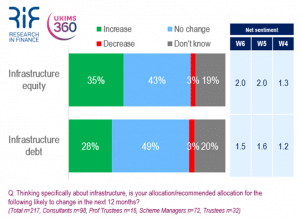25/08/2021
The hunt for diversification and income is pushing more and more asset owners towards unlisted markets.
Uncertainty over future expected returns from traditional asset classes is driving institutional investors to allocate more to private market assets.
Demand has increased significantly over the past decade as investors have sought greater portfolio diversification. Asset supply was boosted by regulations imposed on banks in the wake of the financial crisis of 2007-09, which dramatically reduced banks’ ability to hold risky or illiquid instruments.
The Covid-19 pandemic has renewed investors’ search for alternatives to listed equities and bonds after many were hit by sharp pricing swings in the first half of 2020. While equity and bond markets have since rebounded, record valuations for many leading indices have left many questioning how much potential there is for further gains in these asset classes.
Pension plans assess alternatives
Instead, pension funds and other institutions are increasingly turning to unlisted assets: private equity, venture capital, infrastructure, real estate, and direct lending. These were among the top-performing asset classes in 2020, according to consultancy Cambridge Associates[1], with US private equity and venture capital outperforming US public equities over five, 15, and 25 years.
Similarly, a report by global consultancy McKinsey found that private equity outperformed public markets over the past 10 years and has been the highest-returning asset class in private markets since 2006[2].
While most UK pension funds have been slower to allocate to private markets than other institutional investors, they are looking closely at the asset class, according to Research in Finance’s UK Institutional Market Study (UKIMS), which surveys consultants, pension managers, and trustees on current investment trends.
The most common way to invest in private markets is through multi-asset pooled vehicles – 37% of pension fund respondents reported using this method to access multiple unlisted asset classes. This involves delegating allocations and research functions to a third party, which can be more cost effective than hiring in internal expertise.
Meanwhile, the proportion of consultants recommending private multi-asset pooled strategies has risen to 49%, from 40% in the previous iteration of the UKIMS.
Environmental, social and governance (ESG) considerations are becoming central to investors’ thinking. The Intergovernmental Panel on Climate Change’s latest report[3] has refocused attention on the need for immediate action, which could further accelerate investment into renewable energy assets and construction of other environmentally conscious projects.
Infrastructure’s post-pandemic prospects
The latest UKIMS report clearly shows that infrastructure is now a key asset class for many investors. In the past 12 months, 38% of respondents to the UKIMS raised their infrastructure allocation. Within this sector, 19% of schemes invested in infrastructure debt, while another 19% said they were considering it.
Both infrastructure equity and infrastructure debt have a positive outlook for the next 12 months, according to survey respondents. Just over a third (35%) of UK pension funds were seeking to increase their allocation to infrastructure equity over the next 12 months, while 28% were considering an increase to debt strategies.

The popularity of the infrastructure asset class is reflected in recent industry research from data provider Preqin. At the end of the second quarter of 2021 a record 328 funds investing in infrastructure were in the market raising capital, seeking $238bn between them.[4]
While the sector was hit by pandemic challenges last year, in particular transport and energy assets, this is expected to be temporary.
Commenting in April this year, Alex Murrey, infrastructure spokesperson at Preqin, explained that the telecommunications sector was benefitting greater post-pandemic investment. This sector also offered a potential inflation hedge through exposure to contracted revenues, further boosting its attractiveness to pension funds and insurers in particular.
A recent survey by Aviva Investors found that 40% of global insurers were more likely to invest in infrastructure equity post-pandemic, with the same proportion also keen on infrastructure debt.[5] Endowments and foundations have also been allocating more, with uncalled capital commitments rising across the board over the past five years, according to Cambridge Associates.[6]
Investment consultants are keen on the asset class too. Compared to the previous UKIMS, the proportion recommending infrastructure debt has increased to 32%.
This comes as governments are attempting to encourage private sector backing for the asset class. UK prime minister Boris Johnson recently wrote an open letter to institutional investors urging them to consider increased allocations to domestic infrastructure.[7] Meanwhile, US president Joe Biden’s Infrastructure Investment and Jobs Act is expected to boost both public and private investment into the asset class as he aims to “build back better” from the pandemic.[8]
Those looking for more information on asset allocation trends relating to private assets can find out more in Research in Finance’s UK Institutional Market Study, published annually and available here.
[1] ‘Building winning portfolios through private investments’, Cambridge Associates, August 2021. https://www.cambridgeassociates.com/insight/building-winning-portfolios-through-private-investments/
[2] ‘McKinsey’s Private Markets Annual Review’, McKinsey & Company, 21 April 2021. https://www.mckinsey.com/industries/private-equity-and-principal-investors/our-insights/mckinseys-private-markets-annual-review
[3] ‘Climate Change 2021: The Physical Science Basis’, IPCC, 6 August 2021. https://www.ipcc.ch/report/sixth-assessment-report-working-group-i/
[4] ‘Record 328 Infrastructure Funds in The Market’, Preqin press release, 8 July 2021. https://www.preqin.com/Portals/0/Documents/Infrastructure%20Q2%202021%20Press%20Release.pdf?ver=2021-07-08-141525-453
[5] ‘Pressure points: The investment challenges facing insurers’, Aviva Investors, 5 May 2021. https://www.avivainvestors.com/en-gb/views/aiq-investment-thinking/2021/05/insurers-investment-challenges/
[6] ‘Building winning portfolios through private investments’, Cambridge Associates, August 2021. https://www.cambridgeassociates.com/insight/building-winning-portfolios-through-private-investments/
[7] ‘UK’s Johnson seeks more institutional investment in infrastructure’, Bloomberg, 4 August 2021. https://www.reuters.com/world/uk/uks-johnson-seeks-more-institutional-investment-infrastructure-2021-08-04/
[8] ‘Bipartisan Infrastructure Investment and Jobs Act’, White House factsheet, 2 August 2021. https://www.whitehouse.gov/briefing-room/statements-releases/2021/08/02/updated-fact-sheet-bipartisan-infrastructure-investment-and-jobs-act/